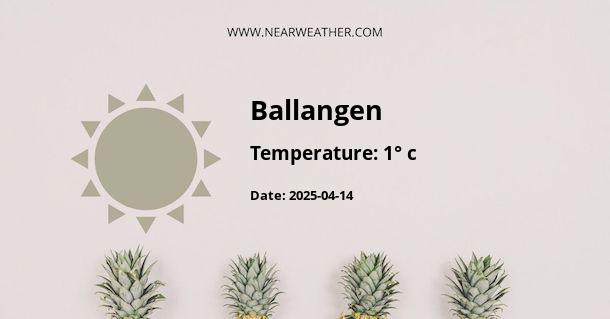Climate and Weather in Ballangen, Norway
Located in the Nordland county of Norway, Ballangen experiences a subarctic climate with relatively mild summers and cold, snowy winters. The region's climate is influenced by its proximity to the Arctic Circle and its position along the Norwegian Sea. In this article, we will explore the climate and weather patterns in Ballangen throughout the year.
Temperature
The average annual temperature in Ballangen is around 3.4 degrees Celsius (38 degrees Fahrenheit), with January being the coldest month and July the warmest. During the winter months, temperatures can drop considerably, with average lows ranging from -7 to -12 degrees Celsius (19 to 10 degrees Fahrenheit). However, it is not uncommon for temperatures to occasionally plummet even further, reaching as low as -20 degrees Celsius (-4 degrees Fahrenheit).
Summers in Ballangen are generally mild, with average high temperatures ranging from 13 to 17 degrees Celsius (55 to 63 degrees Fahrenheit) in July. However, temperatures can occasionally climb higher, reaching up to 25 degrees Celsius (77 degrees Fahrenheit) on rare occasions. The relatively cool summer temperatures are due to the cooling effect of the Norwegian Sea.
Precipitation
Ballangen experiences a significant amount of precipitation throughout the year, with an average annual rainfall of about 1,150 millimeters (45 inches). The wettest months are from September to December, with October being the rainiest month. During this period, the region receives heavy rainfall, often accompanied by strong winds.
Winter in Ballangen is characterized by snowfall, with an average annual snowfall of around 300 centimeters (118 inches). The snowfall begins in November and continues until April, covering the landscape in a beautiful white blanket. The snowy conditions make Ballangen an ideal destination for winter sports enthusiasts.
Sunlight
Due to its high latitude, Ballangen experiences significant variations in daylight throughout the year. During the summer months, the region enjoys long daylight hours, with the sun remaining above the horizon for up to 24 hours during the midnight sun period. This phenomenon occurs from late May to mid-July.
On the other hand, winter days in Ballangen are characterized by short daylight hours, with the sun rising late in the morning and setting early in the afternoon. In December, the darkest month, the region experiences only a few hours of daylight.
Wind
Ballangen is known for its strong winds, particularly during the autumn and winter months. The region is exposed to strong westerly winds coming from the Norwegian Sea. These winds can reach speeds of up to 30 to 40 kilometers per hour (18 to 25 miles per hour) on average, with occasional gusts exceeding 60 kilometers per hour (37 miles per hour).
Climate Trends
Like many other parts of the world, Ballangen has been experiencing the effects of climate change. Over the past few decades, the region has witnessed rising temperatures and changes in precipitation patterns. Winters have become milder, with less snowfall, while summers have seen an increase in heatwaves and occasional heavy rainfall events.
These climate trends have implications for the local environment, wildlife, and outdoor activities in Ballangen. It is important for residents and visitors alike to stay informed about the changing climate patterns and adapt accordingly.
Conclusion
Ballangen, Norway, experiences a subarctic climate with mild summers and cold, snowy winters. The region's proximity to the Arctic Circle and the Norwegian Sea influences its climate patterns. With its beautiful landscapes, winter sports opportunities, and unique daylight variations, Ballangen offers a diverse and exciting climate experience for residents and visitors alike.
A - Ballangen's Latitude is 68.342827 & Longitude is 16.831450.
A - Weather in Ballangen is 1° today.
A - Climate Conditions in Ballangen shows light snow today.
A - Humidity in Ballangen is 93% today.
A - Wind speed in Ballangen is 14.83 km/h, flowing at 360° wind direction. today.
